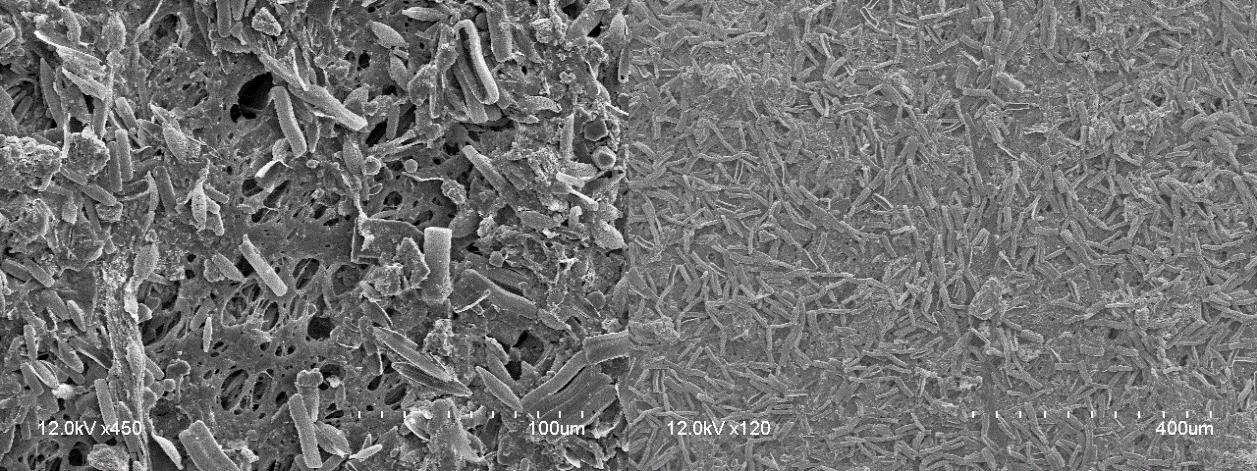Evaluation of the impact of biofouling on deployments of DGT
Deployments of Diffusive Gradients in Thin Film (DGT) devices in environmental waters can be made challenging due to the impact of biofouling. Biofouling is the attachment and growth of undesirable organisms on a surface and can impact the effectiveness of the DGT device. When microbial species such as bacteria and diatoms grow on the surface, they produce a sugar- and protein- rich substance known as extracellular polymeric substances (EPS). EPS spreads across a surface, forming a biofilm and allowing new organisms to attach more easily, including large organisms such as mussels, barnacles, and seaweed. A developed biofilm can affect DGT measurements by blocking the pores of the device, by binding metals, and introducing a new layer on top of the device, changing how metals move through the device.
There are a number of methods to help control the initial buildup of biofouling on a surface. Surfaces that will be exposed to environmental water for a long time, such as the hulls of ships or the casing of sensors, are often painted with biocidal paints, rich in copper or zinc. Alternatively, modified surface coatings can be used to prevent initial settlement or allow for easier removal of developed biofilms. Some sensors use chlorine jets or brushes to clean themselves allowing for longer deployments. However, these methods cannot be easily applied to DGT, as the results would be affected by metallic paints, chemically active surfaces, or changes to the boundary between the water and the device surface. For DGT, controlling the time the devices are deployed is currently the best solution to the biofouling challenge. Under the MONITOOL Project, DGT devices are deployed for 5 days, but evaluation of the impact of biofouling, and the organisms that cause it, is critical. Because MONITOOL covers such a large geographical region, it was expected that the biofouling would vary between hot and cold climates and during different seasons, both in the extent of fouling and the diversity of fouling organisms.
DGT devices were recovered for biofouling analysis from 31 sites during the cooler wet sampling period and the warmer dry sampling period. In addition, during the dry sampling period, Partners deployed panels designed by Dublin City University holding multiple surfaces to test biofouling for extended periods, including two types of membrane filters commonly used on DGT devices. Light microscopy was used to assess the percentage cover of the surfaces by fouling and Scanning Electron Microscopy (SEM) was used to identify the genera of diatoms and the types of other organisms causing fouling.
Many of the devices deployed for 5 days in MONITOOL experienced minimal impact by biofouling, with about half of the deployed devices having less than 1% surface coverage by fouling. This suggests our deployment period is generally suitable for use across various regions. The most heavily fouled device after 5 days was found during the dry season, with approximately 55% surface coverage. A DGT deployed at a nearby site was only about 9% covered, which demonstrates how unpredictable biofouling may be even at closely related sites. However, the longer deployment of the panels led to more than 99% coverage of the surface after 14 days at one site, pictured below.

SEM imaging of the surface of a DGT membrane deployed for 14 days.
Across the 31 studied sites, there were 28 individual genera of diatoms identified on the standard DGT membrane composition (polyethersulphone). Some of these genera appeared at most sites studied, such as "Amphora", "Navicula" and "Cocconeis", which are among the most common marine diatoms. Some regions had diatoms which were unseen in other locations, and sometimes genera such as "Achnanthes" were almost exclusively present, as seen above. Work is continuing on the second surface type, the polycarbonate membranes, deployed alongside the polyethersulphone to better understand the diversity of fouling across the MONITOOL Project regions.



